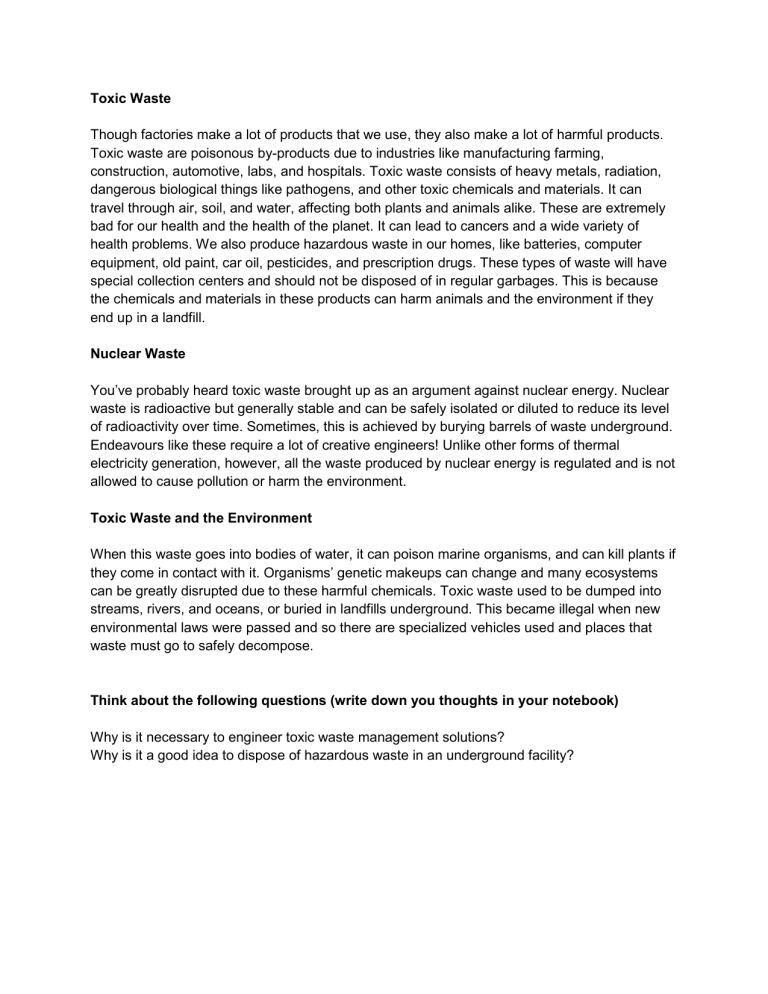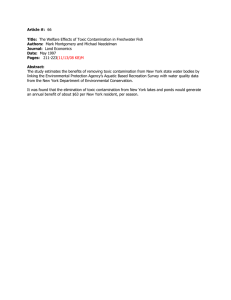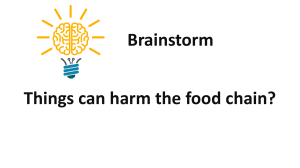Toxic & Nuclear Waste: Environmental Impact & Design Challenge
advertisement

Toxic Waste Though factories make a lot of products that we use, they also make a lot of harmful products. Toxic waste are poisonous by-products due to industries like manufacturing farming, construction, automotive, labs, and hospitals. Toxic waste consists of heavy metals, radiation, dangerous biological things like pathogens, and other toxic chemicals and materials. It can travel through air, soil, and water, affecting both plants and animals alike. These are extremely bad for our health and the health of the planet. It can lead to cancers and a wide variety of health problems. We also produce hazardous waste in our homes, like batteries, computer equipment, old paint, car oil, pesticides, and prescription drugs. These types of waste will have special collection centers and should not be disposed of in regular garbages. This is because the chemicals and materials in these products can harm animals and the environment if they end up in a landfill. Nuclear Waste You’ve probably heard toxic waste brought up as an argument against nuclear energy. Nuclear waste is radioactive but generally stable and can be safely isolated or diluted to reduce its level of radioactivity over time. Sometimes, this is achieved by burying barrels of waste underground. Endeavours like these require a lot of creative engineers! Unlike other forms of thermal electricity generation, however, all the waste produced by nuclear energy is regulated and is not allowed to cause pollution or harm the environment. Toxic Waste and the Environment When this waste goes into bodies of water, it can poison marine organisms, and can kill plants if they come in contact with it. Organisms’ genetic makeups can change and many ecosystems can be greatly disrupted due to these harmful chemicals. Toxic waste used to be dumped into streams, rivers, and oceans, or buried in landfills underground. This became illegal when new environmental laws were passed and so there are specialized vehicles used and places that waste must go to safely decompose. Think about the following questions (write down you thoughts in your notebook) Why is it necessary to engineer toxic waste management solutions? Why is it a good idea to dispose of hazardous waste in an underground facility? Toxic Candy Corn A factory has just created some extremely hazardous candy corn that has a 4-ft diameter, and the toxicity levels are high right up to the ceiling. If the candy corn is not moved within 45 minutes to an area that it can safely decompose, the toxicity will spread throughout the entirety of your city. Your task is to move it into a safe container into which it can safely decompose while the vehicles to move it to a safe place are mobilized. Conditions: • No one may cross the “cylinder of toxic air” with any part of the body. • Candy corn and containers cannot cross the barrier of the cylinder; only the arms of your design • If you spill any candy corn it explodes! Design Challenge You must design a machine / device of some sort that can pour / put the candy corn to a safe container for decomposition. You may not cross the boundaries that indicate the toxic area (as you may die). You must transfer the candy corn from one container to the other without entering the toxic area.


